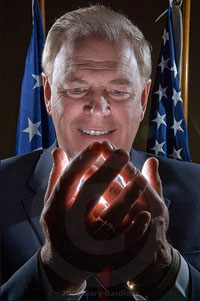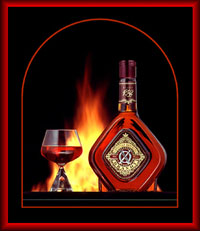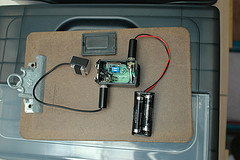
I have almost recovered from Saturday's lighting seminar. I was surprised at how much five hours of talking and demos wore me out. I
must be am definitely getting old.
I thoroughly enjoyed meeting many of you - especially during the dinner at Bare Bones afterward. (Too bad the Ravens choked against the Colts.)
We covered a lot of ground on Saturday afternoon. Given that there was such a wide range of experience in the room, There was a constant balance to bringing everyone along while not letting the more advanced folks get too bored. At least no one actually fell asleep where I could see them.
The afternoon seemed to fly by. For any future sessions, we might consider a whole-day approach, broken into a beginning and an advanced session. That way, someone could choose either or both, and we would have more time.
I especially enjoyed the real-time feedback of the TV monitors and the Q and A. The latter was the only way I could tell when it was time to hit the gas or ride the brakes. That and the occasional blank stare, that is.
Given that we did a lot of real-time thinking aloud and shooting improvisation on the fly, it is important not to lose perspective on the early stuff that was covered. The lighting theory is the basis for everything. The bag-of-tricks stuff flows from that.
Theory will get you the technique. But the technique without the theory is of little lasting value.
I wanted to pull a few of the shots we did up to the main site and give some brief explanations as reminders and for the benefit of those who were not there. Also, I had a couple of surprises pop up after I saw the shots at full size.
We were working pretty fast - at times, very fast - so I did not think to shoot all of the setups. I know you guys shot a lot of what was going on, and if you have any setup shots that might be helpful, please throw them onto Flickr and leave a comment here, so I can link to them.
Actually, feel free to throw up anything that you shot at the workshop into Flickr and note it on the discussion thread. I'd love to keep the discussion going just in case you guys had any unanswered questions and for a variety of other reasons.
FYI for those who were not there, we took a vote with about an hour left and had an overwhelming majority in favor of doing more lighting demos rather than breaking out in to shooting groups. We left the option for those who wanted to break out and shoot to do so, but in the end we all opted to hit a few more setups.
Before I get to the shot setups, I wanted to note a couple of things.
First, thanks again to the kind and super-efficient folks at the
Central Maryland Photographers Guild. Planning just the content part of the seminar was far more work that I anticipated, and to know that everything else was being taken care of was a great relief and help.
Second, I am definitely taking into consideration requests for future seminars in other locations. Google Analytics gives me the ability to know where the site's readership is the most dense. I am bearing that in mind and looking at several locations for future programs.
That said, I am scheduled for another East Coast US workshop in a couple of months which is being put on by another organization. I will post details here as soon as the schedule is announced on their site.
We are also working on something at MPEX for this summer. That may be more of a low-key drop-in/ad hoc kind of thing. Dunno yet. But we're working on it.
Finally, thanks very much to those of you who came and to those attendees who filled out the exit surveys. Your opinions and suggestions are very important when planning future events.
____________________________________________
Workshop Photos
First off is a set of variations done using the
corner headshot technique that I wrote about last spring. For much of the workshop we used
victims volunteers coerced attendees from the audience, and this was no exception.
In the first two of the three photos, there is an umbrella at camera left and a white wall at camera right. I have a white background behind him, as if we were just working in a white corner.
(We were, in fact, working in a white corner. But the wall was painted concrete block and the joints would have introduce patterned reflections of the flash. So we stuck a white Polartech background up instead.)
The difference between the first and second photo is the distance between the subject and the background. By keeping the light-to-subject distance constant and varying the light-to-background distance, we can control the tone of the background.
Similarly, we could have altered the fill light by varying the distance between the subject and the wall. One light, two surfaces, much flexibility and control.
(If anyone has a setup shot of this, post if in Flickr and give me a URL in the comment section here.)
The third shot was also with just one raw flash and set in the same next-to-the-wall location, except we swapped the background to black. The flash was behind David and still at camera left, which is not a typo. Reason is, it was aimed to bounce off the nice, white wall and hit his face from a back/profile angle at camera right. We caught some glare from David's head in the first shot, and merely gobo'd the flash and aimed it to miss him on the way to bouncing off of the right wall.
I did not notice it at first glance on the small camera screen, but we apparently got some "extra help" from a slaved flash somewhere behind me (to my right) as you can see from the frontal hard fill throwing a shadow behind David's ear.

This is one of the last setups we did, in response to a request to do a multi-person shot. This was done in an all-white room, with the color coming from a full
CTO gel on the background light, which was
snooted to limit the beam width.
The front light had a half-CTO gel (from a
free sample pack) to develop the warm theme. This is a subjective call to get away from the neutrality of the room and add a warm color key to the photo.
Here's the setup. I would post it but the photo is restricted by the photographer. The front light was from a hard camera-left angle, and was unmodified. The backlight was from hard camera left and aimed to skim the wall.

From there it was an easy swap to shoot this "found cookie" setup, using a fake tree.
Here's the setup for the tree cookie shot (which is also restricted by the photog) where you can easily see the pattern the tree created. A snoot was used to control the beam width. We used an umbrella to soften the front/side light. We brought it in close for more softness, more efficiency and less spill on the background.

Last but not least is the more complex shot (also seen at the top of the post) using four SB strobes to do some multi-color, 3-D type of lighting.
This was a first-time effort as I had never done a dual-rim SB shot using cool colors from the back. The technique has a lot of potential, IMO, and I will be exploring it more later. The BG flash was neutral, and the two rims were gelled with 1/2 CTB (color temperature blue.) The front was 1/4 CTO warmed. (See the link on gels further up if the abbreviations confuse you.)
Two of the things we explored on this setup was how little light it took (1/64th power) on the black background light to turn it to grey, and the various effects from the different light restrictors we used on the front light.
And here's the
four-light headshot setup, shot (and restricted) by an attendee. We were not quite that, uh, nuclear. (Might consider taking that aperture down a coupla stops!)
If you have questions, reactions, discussion or whatever, feel free to continue the yakking
here. I am off to begin digging out of a mountain of e-mail.


























